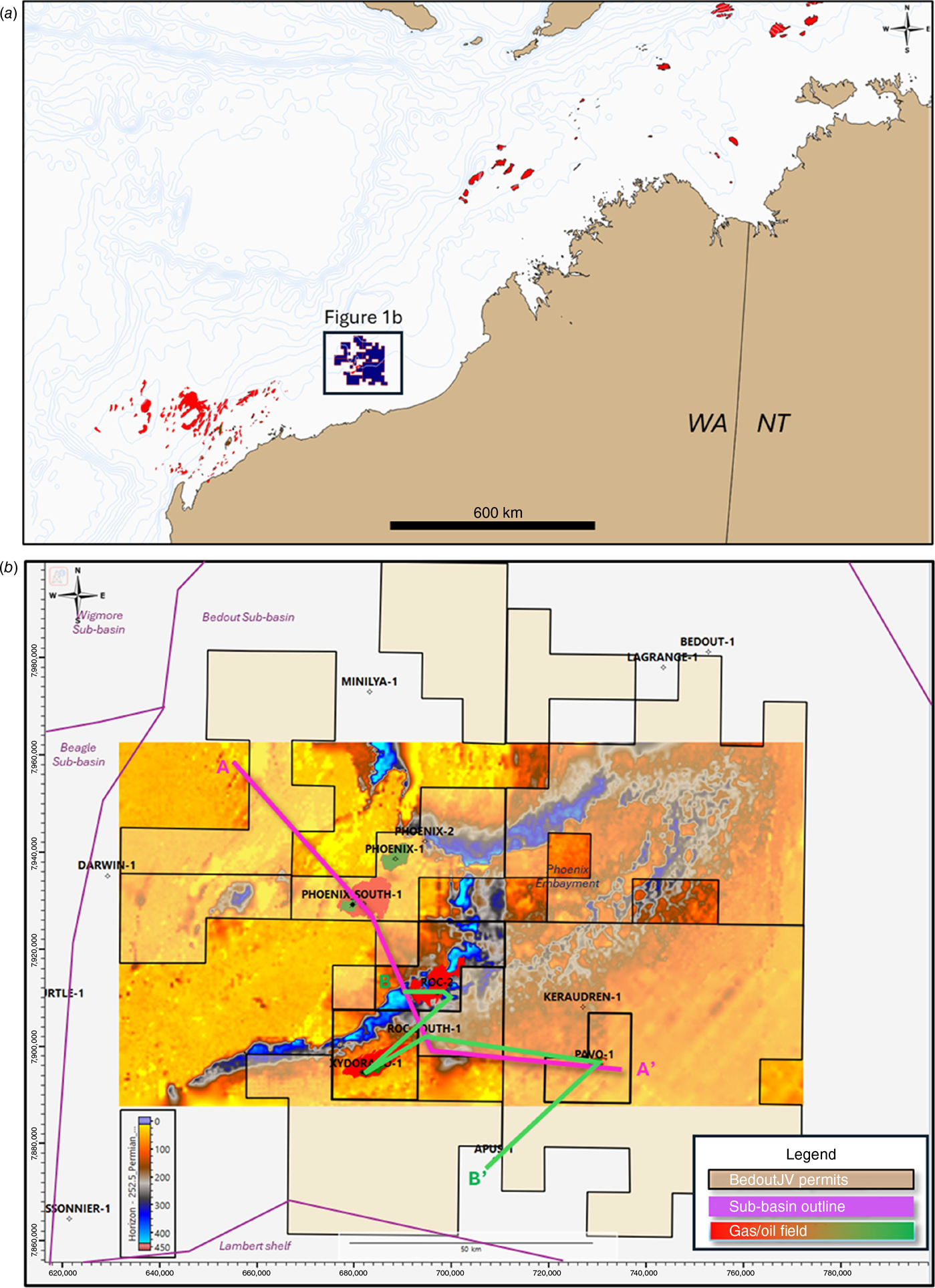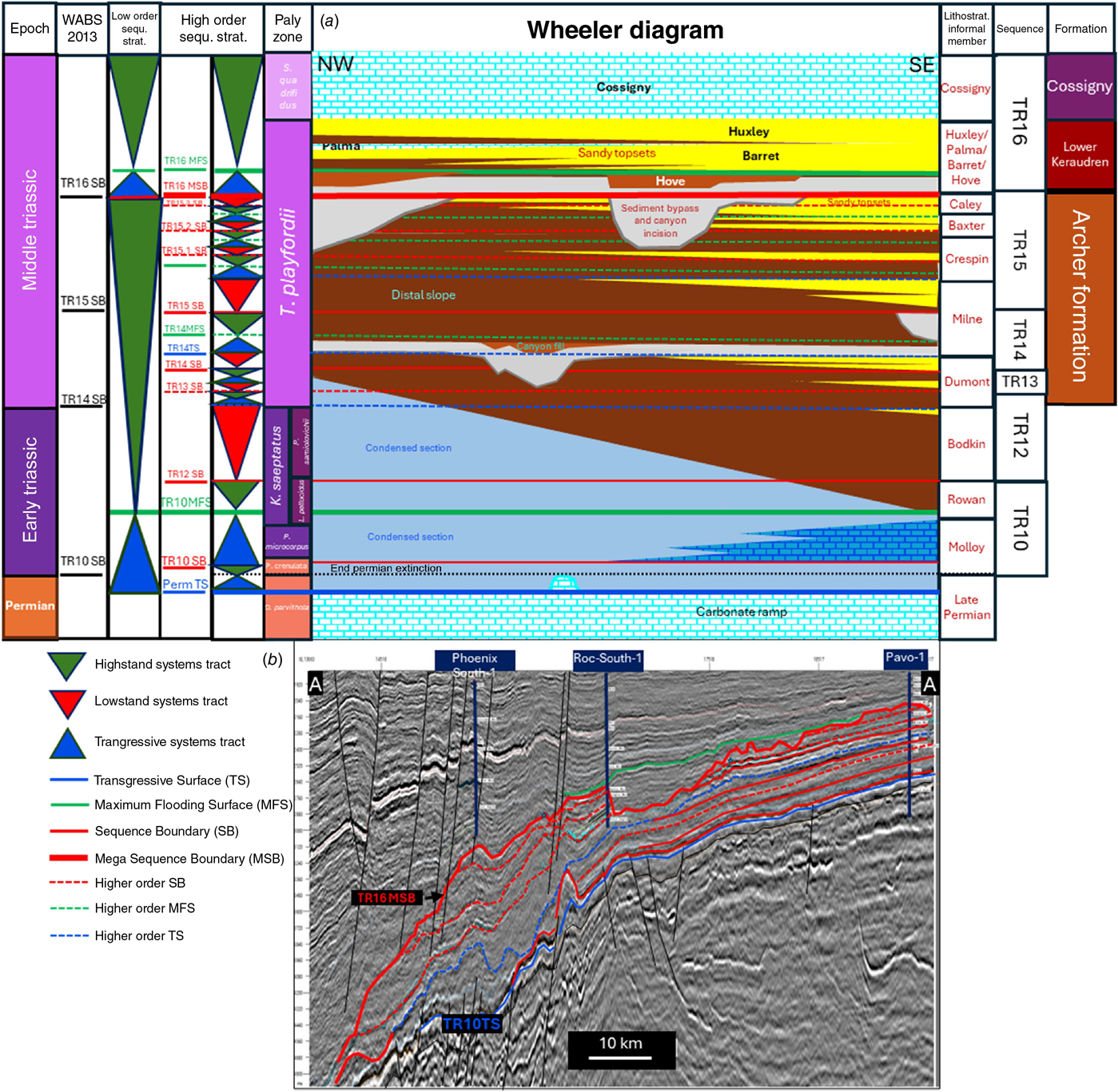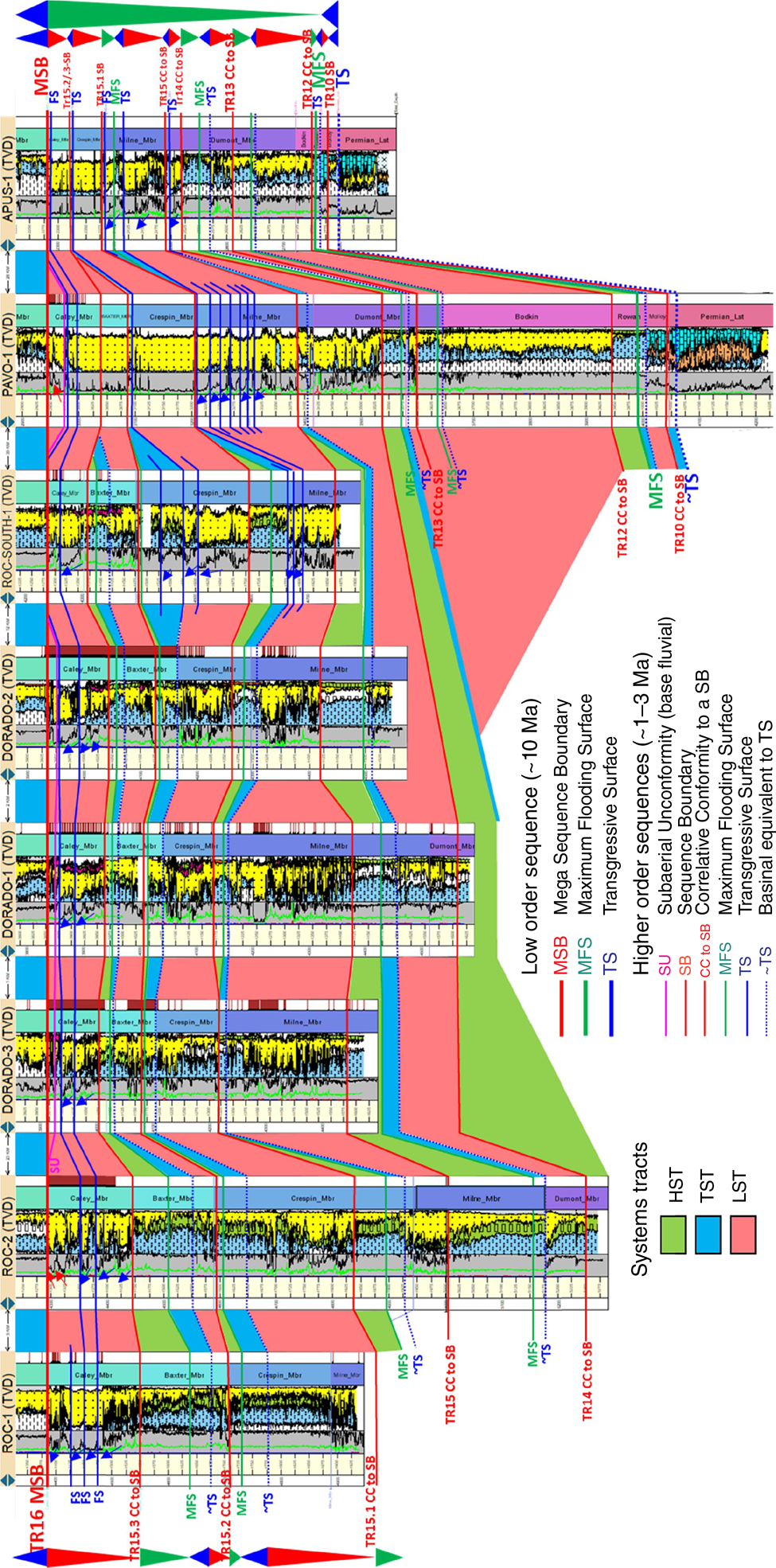New perspectives on the sequence stratigraphy of the Early-Middle Triassic of the Bedout Sub-basin
Roisin McGee A * , George Mills A and Simon Sturrock BA
B

Roisin McGee is the Geoscience Manager at Carnarvon Energy. She holds a BSc in Geophysics from Leeds University, an MSc in Petroleum Geoscience from Imperial College London and an MBA from the University of Western Australia. Roisin began her career at Gaffney Cline and Associates in 2009 before joining Statoil as a geophysicist in Bergen, Norway. In 2013, she relocated to Perth and joined Carnarvon Energy, where she played a key role in the Bedout Joint Venture, contributing to all exploration wells. She is a committee member of PESA WA. |

George Mills is a Senior Geoscientist at Carnarvon Energy. George graduated with a BSc (Hons) degree in Geology and Resource Economics from the University of Western Australia in 2014. In late 2014, George joined Carnarvon Energy as a Geoscientist as part of Carnarvon’s subsurface team. George’s time at Carnarvon has been spent primarily looking at E&P opportunities across the Australian North West Shelf, particularly within the Bedout Sub-basin. George is a member of PESA WA. |

Dr Simon Sturrock is a Director of Strat Trap Pty Ltd, a stratigraphic prediction consultancy specialising in the integration of seismic, well and outcrop data, using sequence stratigraphic principles, for prospect generation and detailed field appraisal projects. Simon holds a BSc in Geology from Exeter University and a PhD in Geology. Simon possesses extensive international exploration experience, including 11 years with BP and 30 years as an independent consultant. Simon is currently a member of the GESGB and PESA. |
Abstract
The Bedout Sub-basin, part of the Roebuck Basin on Western Australia’s North West Shelf, has drawn interest since hydrocarbon discoveries at Roc, Dorado and Pavo. Despite these successes, the region remains underexplored. This study applies sequence stratigraphic analysis, well data and 3D seismic data to characterise the basin’s depositional history and hydrocarbon potential. A Wheeler diagram illustrates chronostratigraphic relationships, identifying key sequence stratigraphic play systems. Findings reveal a shallowing-upward trend from the Early to Middle Triassic, a new play system in Late Permian carbonates and highlight that the Archer reservoir sands are a series of low-stand deposits. These insights refine the Bedout Sub-basin’s stratigraphic framework and inform future exploration efforts.
Keywords: Archer, Bedout, Dorado, Early Triassic, Middle Triassic, sequence boundary, sequence stratigraphy, systems tracts, wheeler diagram.
Introduction
The Bedout Sub-basin lies within the Roebuck Basin on Western Australia’s North West Shelf (Fig. 1). The recent hydrocarbon discoveries made at Roc, Dorado and Pavo have heightened interest in the basin. Despite this, the Bedout Sub-basin remains significantly underexplored.
(a) Location of the Bedout area of interest on the Australian North West Shelf. (b) Permit map with Permian carbonates – isopach map highlighting the Late Permian carbonate margin and basin geomorphology.

The Bedout Sub-basin’s formation was initiated by the early Permian East Gondwana Interior Rift (Minken et al. 2019), with the basin subsequently filled by Permo-Triassic and Jurassic sediments. Thompson et al. (2019) and Minken et al. (2019) cover the basin’s exploration and tectonostratigraphic history. However, the drilling of Pavo-1 and Apus-1 in 2022 provided the first continuous stratigraphic insights into the Early Triassic and Permian successions.
Dataset
The area of interest (AOI) for this study is the Bedout Sub-basin (Fig. 1). So far, 12 of the 17 wells drilled in the AOI have penetrated Middle Triassic or older stratigraphy. The most recent wells, Apus-1 and Pavo-1 (2022), are the only ones to intersect Early Triassic and Permian stratigraphy. Over 80% of the AOI is covered by high-quality 3D seismic data, enabling comprehensive regional seismic interpretation of key stratigraphic surfaces. A Wheeler diagram (Fig. 2a) visualises the sequence stratigraphic development of the Early-Middle Triassic in the Bedout Sub-basin, highlighting key depositional sequences.
(a) Wheeler diagram interpretation of (b) interpreted arbitrary seismic line (line A-A′, Fig. 1).

The Arbitrary 3D seismic line behind the wheeler diagram (Fig. 2b) extends from the basin’s eastern flank into the main depocenter, intersecting the Pavo-1, Roc South-1, and Phoenix South-1 wells. The Pavo-1 well provides calibration for the Early Triassic and Permian successions.
Discussion/results
The latest Permian to early Triassic stratigraphy in the Bedout comprises a transgressive to regressive low-order sequence of about 10 Ma duration, which commenced in the Late Permian and terminated at the tectonically induced Caley Unconformity (TR16 MSB) when the Bedout High was rejuvenated (Minken et al. 2019).
A modified three-stage systems tract sequence stratigraphic model has been used to interpret the data. The low-order highstand (HST) regression is interpreted to comprise up to 7 higher order (1–3 Ma) sequence boundaries (SB) and associated siliciclastic lowstand (LST) regressions. These are separated by thin, distal, fines-dominated, transgressive marine (TST) and HST deposits in the Roc and Dorado wells, while in the Pavo-1 and Apus-1 wells, the HST deposits have largely been eroded (Fig. 3).
Bedout Sub-basin: sequence stratigraphic analysis
Late Permian
The Late Permian carbonates at the base of the Wheeler diagram, represent a widespread heterozoan carbonate ramp that was transgressed and drowned in the latest Permian, as subsidence outpaced carbonate growth. During transgression, an attached carbonate platform formed on the southern Bedout High, a carbonate-rimmed wall developed near the Roc field, and carbonate mounds emerged along the SE Phoenix embayment (Fig. 1b). These structures could potentially serve as hydrocarbon traps. Pavo-1 and Apus-1 intersected inner ramp carbonates with Bryozoan, Echinoderm, and Brachiopod debris in a silty, argillaceous matrix. Carbonate growth ceased with the end-Permian mass extinction, after which the drowned shelf continued subsiding.
Early Triassic
A second carbonate system developed in the earliest Triassic (Molloy Member, P. microcorpus) in the eastern Bedout Sub-basin, probably linked to a fall in relative sea-level, as thin sections from Apus-1 indicate a low-energy lagoonal facies with bivalve, gastropod, and ostracod shells. The extent of the sea level fall is uncertain, but it may have exposed and karstified the latest Permian potential carbonate reservoirs.
At Pavo-1, Molloy Palynofacies show rising acritarch levels, peaking at the Top Molloy, indicating continued subsidence and marine transgression, culminating in a major maximum flooding surface within the fines-dominated Rowan Member. Rowan has abundant freshwater algae and decreasing acritarchs, which are interpreted as distal HST deposits with deltaic equivalents to the east of the AOI.
High Botryococcus content with strong fluorescence suggests an anoxic environment, making the Rowan Member a potential type C source rock (Pepper and Corvi 1995) within lagoons formed by Permian carbonate architecture.
A correlative conformity (CC) to an SB is interpreted at the base of the Bodkin Member (K. saeptatus zone) in Pavo-1 and Apus-1. This TR12 SB marks the onset of Early Triassic submarine fan deposition in the Bedout Sub-basin, consisting of thin, distal turbiditic sandstones and siltstones within the shale-dominated Bodkin Member. Distal transgressive and highstand fines of the Lower Dumont (T. playfordii) overlie the Bodkin distal LST submarine fan.
A CC to an SB is interpreted in the Lower Dumont Member. This is the TR13 SB, which lies within the early T. playfordii zone in Pavo-1 and Apus-1. A thin interval of stacked turbiditic sandstones and siltstones overlay the SB. Distal transgressive and highstand fines overlie the lower Dumont LST submarine fan.
A CC to an SB is interpreted in the Upper Dumont Member (T. playfordii zone) at Pavo-1, Apus-1, and the base of Dorado-1 and Roc-2 wells, defining the TR14 SB. Thick, cleaning up, stacked turbiditic sandstones and siltstones, some possibly channelised in Pavo-1 overly this CC. In Dorado-1, -2, and Roc-2, the submarine fan sandstones are thinner and sparser, while in Apus-1, they are significantly thinner, with a cleaning log character at the top, possibly indicating more proximal deposits.
The top Dumont Member is marked by a transgressive surface (TS), correlating with an incised canyon seen on 3D seismic near Keraudren-1, transporting sediments westward. This canyon is filled with transgressive fine-grained deposits. Distal transgressive and highstand fines overlie the Upper Dumont LST submarine fan in Dorado-1, -2, and Roc-2. In Pavo-1 and Apus-1, only transgressive fines remain, with highstand fines eroded at this proximal location.
The TR15 play system hosts the Roc, Dorado and Pavo field reservoirs and four rapidly deposited high-order play systems.
TR15-SB: a CC to an SB occurs near the base of the Milne Member in Roc-2, Dorado and Roc South-1, with an erosive SB in Pavo-1 and Apus-1. The CC is overlain by stacked, cleaning- and thickening-up turbiditic sandstones, channelised in Dorado and Roc South-1, and cored in Dorado-3. In Pavo-1, stacked channelised submarine fan sandstones transition abruptly into six aggradational parasequences, forming a lowstand wedge. Apus-1 features a similar but thinner section, capped by a massive shoreface sandstone, suggesting a more proximal setting. Roc South-1 has stacked turbiditic and channelised sandstones overlain by two retrograding parasequences. Highstand and transgressive fines cap the sequence, except in Pavo-1 and Apus-1, where preservation is limited.
TR15.1-SB: a CC to an SB occurs near the base of the Crespin Member, marking the transition to Crespin turbiditic sandstones channelised in Roc-2 and Dorado. Pavo-1 and Apus-1 instead contain thick, massive shoreface sandstones. Distal transgressive and highstand fines overlie the submarine fan deposits in Dorado wells and Roc-2, while only thin transgressive fines remain in Pavo-1 and Apus-1.
TR15.2-SB: a CC to an SB occurs near the base of the Baxter Member, overlain by stacked, channelised turbiditic sandstones in Dorado-1, -2, -3 and Roc South-1, and cored in Dorado-3. The submarine fan is thinner in Roc-1 and -2. Except for Roc South-1, all wells show a fining-up profile, with Dorado-3 core containing slumped sandstones and siltstones, indicating slope instability. Distal transgressive and highstand fines overlie the Baxter submarine fan. Correlation to Pavo-1 is uncertain, but the best match is a massive, lowstand, shoreface sandstone resting abruptly on the SB.
TR15.3-SB: a CC to an SB occurs at the base of the Caley Member in Roc, Dorado, and Roc South-1, with an erosive SB in Pavo-1 and Apus-1. The abruptness of this SB may indicate a potential falling stage systems tract (FSST) driven by the onset of rejuvenated uplift of the Bedout High. The CC is overlain by stacked, thickening and cleaning-upward shoreface and mouth bar sandstones, bounded by bioturbated siltstones and fine sandstone flooding surfaces. Correlation to Pavo-1 and Apus-1 is challenging due to massive shoreface sandstones. In the Dorado wells and Pavo-1, distributary channel sandstones overlie the shoreface units, indicating a subaerial unconformity (SU) at the base of a fluvial system.
TR16-MSB (Caley Unconformity) marks the Archer Formation top and the Lower Keraudren Formation base. It represents a tectonically driven mega sequence boundary (MSB) linked to the rejuvenated uplift of the Bedout High, erosion of the Dorado and Apus Canyon canyons and a shift in sediment provenance (Thompson et al. 2019). The overlying Hove, Palma, Barret, Huxley and Cossigny Members correspond with the TR16 sequence of Marshall and Lang (2013).
The Hove Member is a transgressive shale that fills the canyons formed by the Caley Unconformity (TR16 MSB). These shaley deposits act as top seals at the Roc, Dorado and Pavo fields. Canyon axes have not been penetrated, but the recorded presence of distributary channels in the immediately underlying Caley Member in the Dorado-2 and -3 cores suggests incised fluvial systems likely occurred during the rejuvenated uplift of the Bedout High. The Barret Member represents the topsets associated with the TR16 delta system and is hydrocarbon-bearing in Phoenix-1, Phoenix-2 and Phoenix South.
Summary and conclusions
The sequence stratigraphic analysis of the Bedout Sub-basin provides valuable insights into its depositional evolution and petroleum system potential. The study highlights the Archer Formation sands are low-stand deposits and also identify a Permian Carbonate play system. Integrating well data, seismic interpretation, and biostratigraphic analysis has enhanced understanding of sedimentary processes and depositional environments. Future exploration efforts will refine the stratigraphic framework and evaluate the effective reservoir distribution to unlock the full potential of the basin.
Data availability
The seismic data supporting this study were obtained from TGS by permission/licence. Data may be shared with permission from TGS. The well data that support this study are available in NOPIMS at ENO0810726 and ENO0810734.
Acknowledgements
The authors would like to acknowledge John Lignum and Daniel Mantle at MGP for their great discussions on palynology and dating, and Terry Walker for his independent review.
References
Minken J, Thompson M, Woodward J, Ryan R, Fabrici R, Allen M, Fernandes F (2019) Tectonics of the Bedout Sub-basin and deposition of the Archer and Lower Keraudren Formations; influence of tectonics in a rapidly deposited succession. In ‘Proceedings of the Petroleum Exploration Society of Australia Symposium. The Sedimentary Basins of Western Australia V’. (Eds M Keep, SJ Moss). (PESA: Perth)
Pepper AS, Corvi PJ (1995) Simple kinetic models of petroleum formation Part I: oil and gas generation from kerogen. Marine and Petroleum Geology 12(3), 291-319.
| Crossref | Google Scholar |
Thompson M, Woodward J, Minken J, Ryan R (2019) Unravelling the Lower Keraudren petroleum system in the Bedout Sub-basin: some early observations. In ‘Proceedings of the Petroleum Exploration Society of Australia Symposium. The Sedimentary Basins of Western Australia V’. (Eds M Keep, SJ Moss). (PESA)
 Roisin McGee is the Geoscience Manager at Carnarvon Energy. She holds a BSc in Geophysics from Leeds University, an MSc in Petroleum Geoscience from Imperial College London and an MBA from the University of Western Australia. Roisin began her career at Gaffney Cline and Associates in 2009 before joining Statoil as a geophysicist in Bergen, Norway. In 2013, she relocated to Perth and joined Carnarvon Energy, where she played a key role in the Bedout Joint Venture, contributing to all exploration wells. She is a committee member of PESA WA. |
 George Mills is a Senior Geoscientist at Carnarvon Energy. George graduated with a BSc (Hons) degree in Geology and Resource Economics from the University of Western Australia in 2014. In late 2014, George joined Carnarvon Energy as a Geoscientist as part of Carnarvon’s subsurface team. George’s time at Carnarvon has been spent primarily looking at E&P opportunities across the Australian North West Shelf, particularly within the Bedout Sub-basin. George is a member of PESA WA. |
 Dr Simon Sturrock is a Director of Strat Trap Pty Ltd, a stratigraphic prediction consultancy specialising in the integration of seismic, well and outcrop data, using sequence stratigraphic principles, for prospect generation and detailed field appraisal projects. Simon holds a BSc in Geology from Exeter University and a PhD in Geology. Simon possesses extensive international exploration experience, including 11 years with BP and 30 years as an independent consultant. Simon is currently a member of the GESGB and PESA. |



